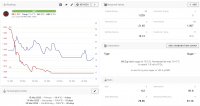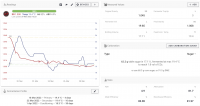x3la
Well-Known Member
I am consistently getting high attenuation for my batches regardless of the yeast strain.
All of my batches are British Ale; Bitter, Porter, Milds etc.. nothing boozy.
My last two brews with Wyeast 1469, I hit 82% for both. For Wyeast 1187 I hit 78%
I make a starter according to BeerSmith or Brewfather's calculations tools and use a stir plate.
My current brew process is on an Anvil Foundry with no-sparge but I have this same issue on my 3 vessel fly-sparge propane setup.
I mash in at 66c for 60 minutes and then mash out by raising the temperature with a ramp time of 8 minutes to 76c and then hold it for 10 minutes.
I achieve 80-83% mash efficiency.
My grain bill is generally 90%-100% Maris Otter, the rest generally being Crystal, milled with a gap setting of .030
I attach two images of what is a typical fermentation in my apartment. I have some excursions above the recommended fermentation temperatures.


Thanks in advance for any help or pointers!
All of my batches are British Ale; Bitter, Porter, Milds etc.. nothing boozy.
My last two brews with Wyeast 1469, I hit 82% for both. For Wyeast 1187 I hit 78%
I make a starter according to BeerSmith or Brewfather's calculations tools and use a stir plate.
My current brew process is on an Anvil Foundry with no-sparge but I have this same issue on my 3 vessel fly-sparge propane setup.
I mash in at 66c for 60 minutes and then mash out by raising the temperature with a ramp time of 8 minutes to 76c and then hold it for 10 minutes.
I achieve 80-83% mash efficiency.
My grain bill is generally 90%-100% Maris Otter, the rest generally being Crystal, milled with a gap setting of .030
I attach two images of what is a typical fermentation in my apartment. I have some excursions above the recommended fermentation temperatures.


Thanks in advance for any help or pointers!




































![Craft A Brew - Safale S-04 Dry Yeast - Fermentis - English Ale Dry Yeast - For English and American Ales and Hard Apple Ciders - Ingredients for Home Brewing - Beer Making Supplies - [1 Pack]](https://m.media-amazon.com/images/I/41fVGNh6JfL._SL500_.jpg)






















